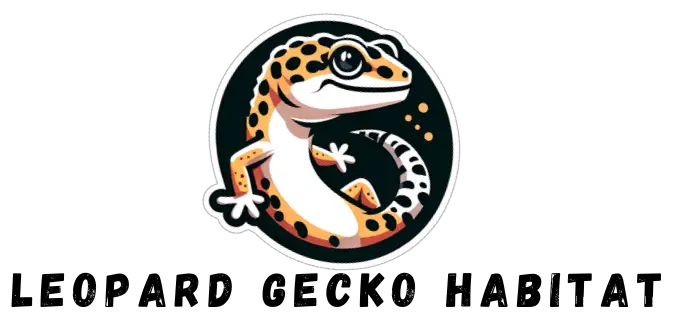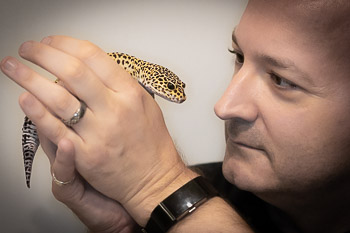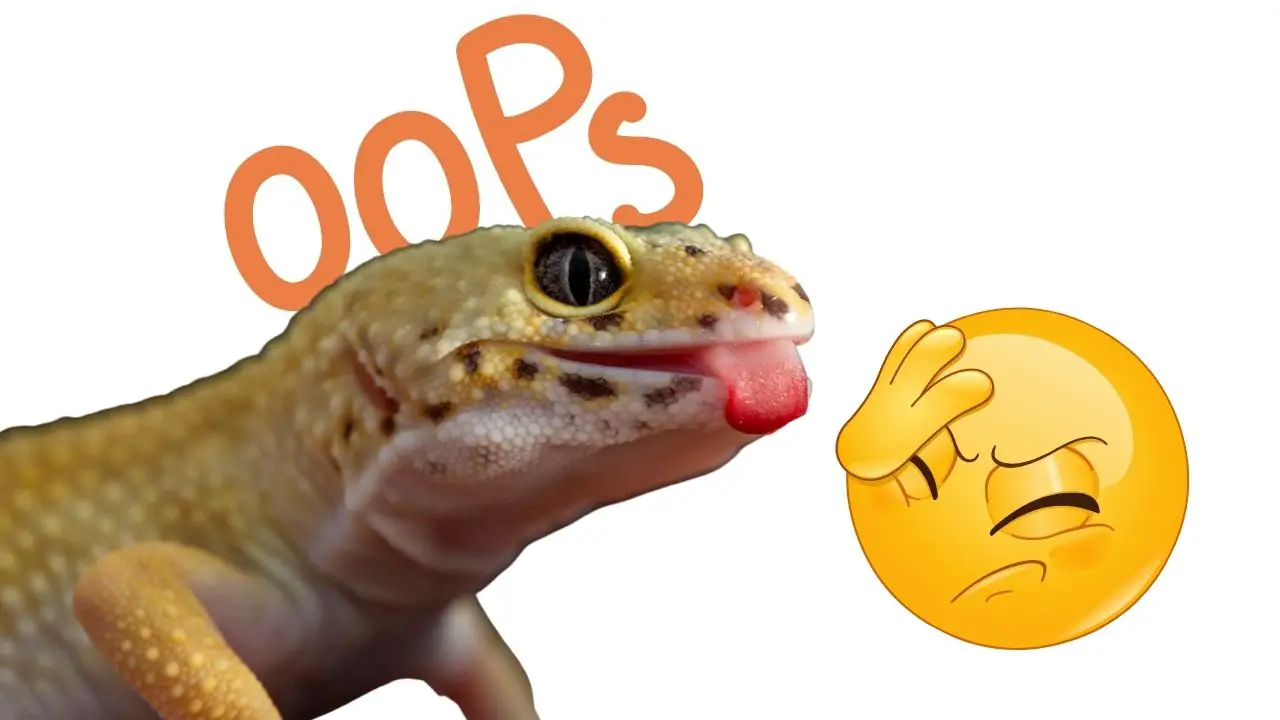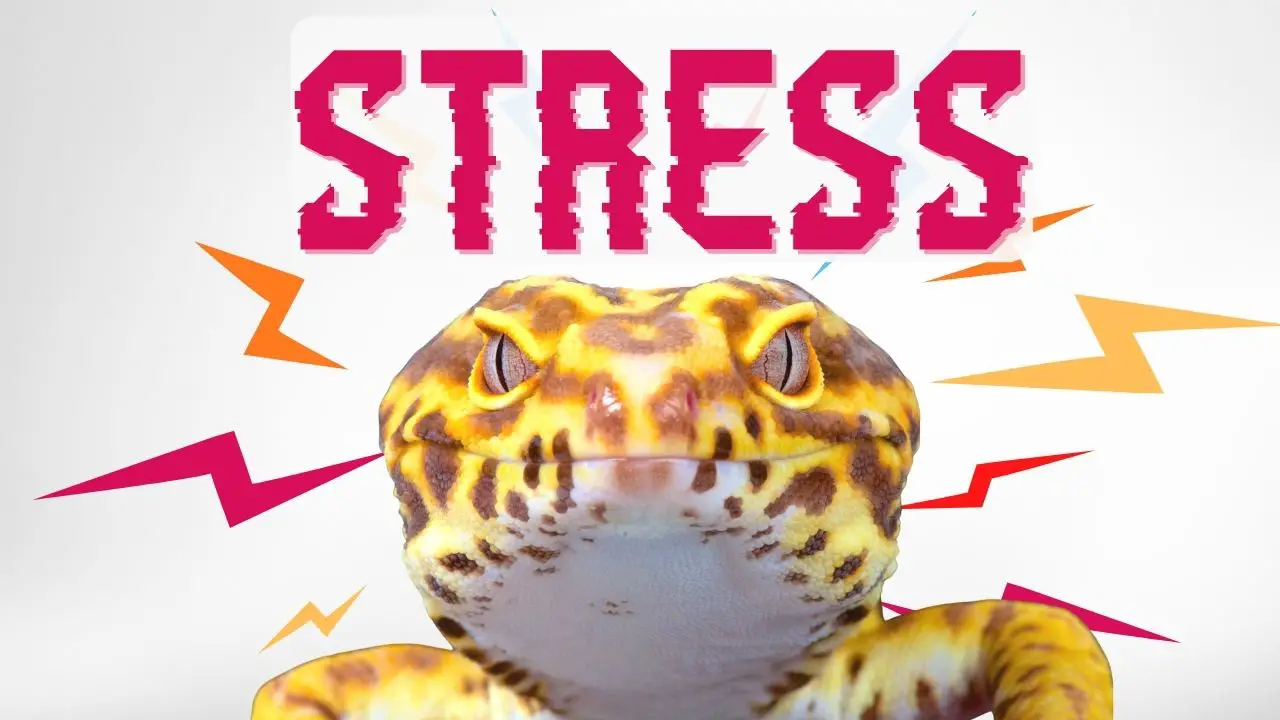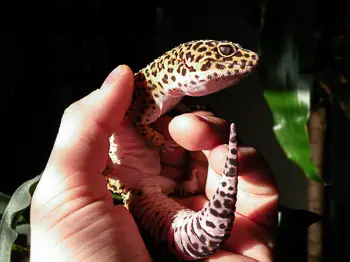Even with the best of care, your beloved leopard gecko may get sick. Here are a few things to watch out for and what you can do to prevent illness.
If you’re asking, “How do I know if my leopard gecko is sick” or “What do I do if my leopard gecko is sick?” then please continue reading:
Impaction
This is one of the most common things that may happen to your gecko. Impaction happens when your gecko eats something that gets stuck (or impacted) in its digestive tract. The impaction will block the normal ‘flow’ of the digestive process. In other words, your gecko can’t poop.
Cause of Impaction
Sand substrate is a common cause of impaction, especially with small geckos. This is why we don’t recommend using sand, calcium sand, or loose materials as a substrate.
Food items that are too large for your gecko to digest may also cause impaction. As a quick guide, you should offer insects no larger than the space between your gecko’s eyes.
Treating Impaction
A warm bath and a gentle belly rub may help soften the stool and move the impacted material through the digestive tract. Raising the temperature a few degrees will help to raise your gecko’s metabolism which may also help move things along.
If the impaction remains, it may require a trip to the vet and surgery to remove the blockage.
Read more in our full post about leopard gecko impaction
Metabolic Bone Disease (MBD)
Metabolic Bone Disease may occur if your leopard gecko does not get enough calcium. If your leopard gecko is not getting enough calcium, the body will start leaching calcium from the bones. This could cause skeletal deformities and weak bones.
Your gecko may have difficulty walking or its legs may appear flimsy or twisted. Or, most probably, both.
If you want to see an example of a leopard gecko with MDB, you can check out the poor lizard in the leopard gecko rescue video below:
There is no ‘cure’ for MDB, and the effects are not reversible. You can stop the disease from becoming more advanced with proper nutrition and dietary supplements.
Hemipenile Prolapse
I’ve had fairly good luck with the overall health of my leopard gecko, but this one scared me. One day when our gecko, Dude, was cleaning himself, I noticed an oddly colored bit of skin underneath his tail. Further inspection revealed he had an angry looking red bit of skin protruding from one of the slits at the base of this tail. It did not look healthy.
Unfortunately, my favorite vet (who happened to specialize in exotics) had left our local animal hospital. I had to call around to several local vets to find one that could diagnose and treat reptiles. (Note that all veterinary practices may not have someone on staff that treats reptiles.) It was winter, so I packed our gecko in a box with a small heat pack (warm, not hot), and headed to the vet.
He was diagnosed with a Hemipenile Prolapse, which is every bit as scary as it sounds. The hemipenis is the male leopard gecko’s reproductive organ, which belongs on the inside when they are not mating. When exposed for extended periods, it can dry out and turn necrotic if not corrected. If not treated, it could be fatal.
After consulting with the vet, the organ was reinserted. I was given instructions on how to guide things back into place should it slip out again and the vet was unavailable. The vet was kind enough to provide supplies and prescribe an antibiotic cream. I can tell you both Dude and I felt better with all of his bits back inside where they should be.
Hemipeinile Prolapse is common among breeding geckos, but Dude has always lived as a bachelor. I’m still curious how it happened, but figure it’s best for both of us if I don’t ask him too many questions.
Stick Tail or Skinny Tail
Skinny Tail, or Stick Tail are terms for weight loss in your gecko. This isn’t the good kind of “finally hitting your goal of shedding a few pounds” kind of weight loss, but a sign your leopard gecko is sick or malnourished. Or both.
When a gecko loses weight and body mass, often times its tail will start to get thinner as it burns through its fat store.
Look for these signs of Stick Tail:
- Tail is thinner than your gecko’s body
- Tail is straight with little curve
- Tailbones are visible through the skin
- Your leopard gecko refuses food
Should your leopard gecko’s tail, at its widest point, become thinner than its body, you should be mindful of your gecko’s diet and how much nutrition it is getting. When the tail is more strait than curvy and begins to resemble a stick or you can see the tailbones through the skin, your gecko is in trouble. Simply feeding it more may not be the answer (and it may not want to eat.)
This could be serious and warrants a visit with a qualified exotics vet. The vet will most likely take fecal samples to test for parasites.
A common cause of stick tail is that the gecko has picked up an intestinal protozoal parasite called Cryptosporidium, sometimes shortened to Crypto. Infected leopard geckos can pass the parasite on to others, even if they are not showing signs of the sickness themselves. Leopard geckos with crypto may refuse to eat or eat very little and may pass undigested food.
You’ll want to quarantine a gecko with stick tail, and take it to a vet that specializes in exotics.
If the cause of the condition is parasites, your vet will most likely prescribe medication, which will get rid of the parasites and allow your gecko to start getting back to a healthy weight.
Lost or Dropped Tail
It may seem like a traumatic experience should your pet lose its tail (both for you and your lizard.) Generally, it will heal on its own, as it is designed to do.
If you have substrate that may irritate or infect the wound, you’ll want to get your gecko onto something like paper or paper towel while it is healing.
If your gecko lives in a tank with other geckos, you may want to isolate it for some time while it is healing.
Make sure your leopard gecko is getting plenty to eat. It just lost its fat store, and needs calories and energy to sustain itself and grow back its tail.
You can read more about a leopard gecko’s tail in this article: Leopard Gecko Tails: 5 Interesting Facts
Tail Rot
Tail rot is most commonly caused by a bacterial infection. If left untreated, the infection will spread killing healthy tissue and spreading through the body and internal organs.
Tail rot is best treated by a qualified veterinarian. For more on symptoms, causes, treatment, and prevention check out our article on leopard gecko tail rot.
Seizures
A leopard gecko seizure can cause the reptile to become unresponsive, twitch or even roll onto its back in what is known as a death roll. Gecko owners should be aware of the common signs of a seizure such as refusing to eat, sudden change in behavior, erratic movements, or lack of responsiveness. To find our more, read our article on leopard gecko seizures.
How to help prevent sickness in Leopard Geckos
- Scoop the Poop
- Stray crickets or feeder insects may eat your gecko’s feces. Your gecko will eat the insects and in turn, it its own – you get the idea.
- Proper Nutrition
- Make sure your leopard gecko has a proper diet and some variety in the feeder insects offered
- Provide the appropriate supplements
- Food from Trusted Sources
- Insects caught in the wild could be carrying diseases or have been exposed to pesticides. Buy your feeder insects from trusted sources, or breed your own.
- Check our Complete Feeding Guide here and foods to avoid.
- Proper Hygiene
- If you’re handling your gecko and have been exposed to parasites or diseases, it is possible you could pass these to your gecko. This is especially true if you have other reptiles and move from handling one pet to the other. Washing your hands can greatly reduce the risk.
- Quarantine
- If you have multiple geckos in the same enclosure, it’s important to isolate any of them should you suspect sickness. This will reduce the risk of the illness spreading.
- Similarly, you should quarantine new leopard geckos or breeding partners before introducing them to an enclosure housing other geckos.
- Proper Humidity and Shedding Care
- Make sure you have a moist hide or mist your tank when your leopard gecko is ready to shed
- Take care with shed skin that remains behind, especially on the feet and toes
Related Post: Sickness and stress often go hand in hand. Find out how to notice if your leopard gecko is stressed and, more importantly, help prevent stress.
Lastly, you can check for signs your leopard gecko is dying. If you think your pet is in trouble, please seek care with a qualified veterinarian that specializes in reptiles. Getting proper care early can make all the difference in keeping your pet healthy.
